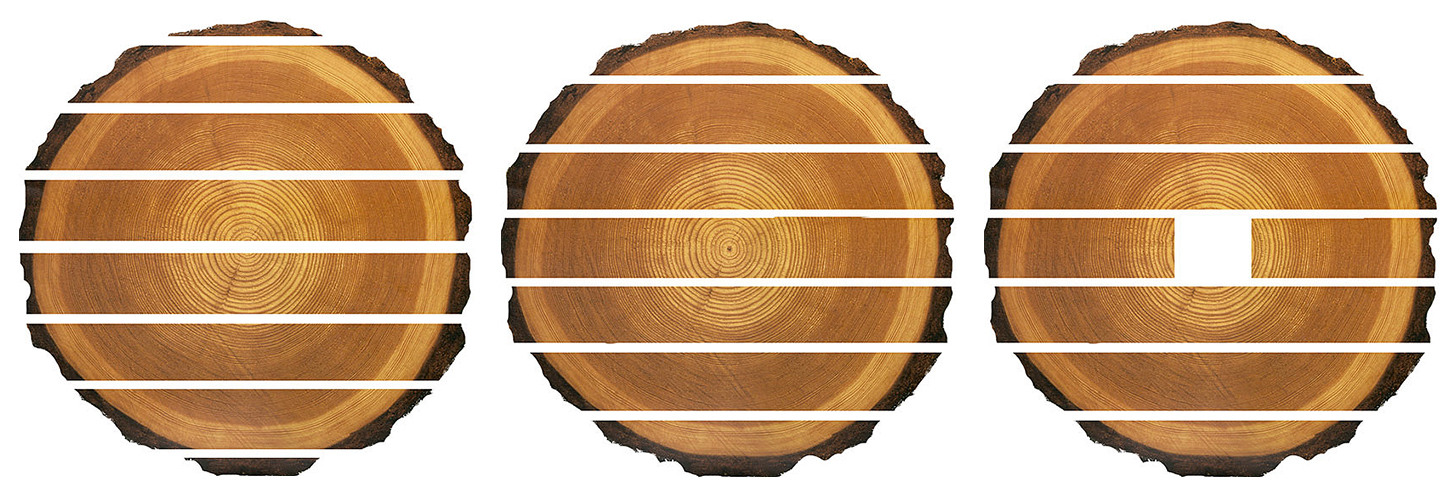Principles of cutting
There are two main principles of sawmilling logs, Scandinavian and North American. In the Scandinavian way, the log is cut parallel to the centre line of the log. It can also be called a longitudinal cut. In the North American superficial cut, the log is cut parallel to the surface of the log. However, the Scandinavian way of cutting is also widely used in North America.
Longitudinal cut (Scandinavian) = Cutting parallel to the centre line of the log results in plenty of sawn wood, but the branchless sapwood produces only batten.
Superficial cut (North American) = Cutting parallel to the surface of the log has three advantages:
1. The valuable sapwood can be used precisely.
2. The cutting is parallel to grains.
3. Only heartwood, the poorest part of a log, is wasted.
Ways of cutting
In through sawing the log will first be cut into batten, plank and board as thick as required. Next the sawn timber is edged: the surface will be removed and the width of sawn timber goods will be determined. Through sawing is used most often when cutting deciduous woods, in Finland mainly in cutting birch and alder. By using through sawing the deciduous wood is yielding more timber wood than by double cutting. The purpose of use and the cone-shaped and flexible trunk of the deciduous wood also favour through sawing. Quite often the through sawn wood is edged both longitudinally and superficially.

Double cutting has two phases. First, you cut side boards on both sides of the log. The side boards will, then, be edged. The remaining part of the log in the middle is called a balk. Next you turn around the balk 90˚ and cut batten, plank and board as thick as required.

The middle parts do not need to be edged. Double cut is the most common way of sawmilling in Finland. Double cut is the most economical way in industrial processes.
Double cut is mainly used in sawing coniferous wood. It is a natural way also to cut log billets.
Other ways of sawmilling logs
Other ways of sawmilling logs are for instance pattern cut and various combinations of different ways of cutting, for instance pith free pattern cutand the combination of through sawing and radial sawing. These ways of sawmilling logs are used when you want the sawn wood to have certain specific characteristics such as grains on the surface, moisture ratio and dimensional stability. Often the purpose of cutting is the vertical direction of growth rings compared to the surface of the sawn wood.

Through sawing and pattern cut are the most common ways in Finland, where as in the Central Europe the other ways of cutting are more usual.
Ordinary pattern cut leaves the growth rings as vertical as possible compared to the sawn surface, in which case the wood does not warp and twist so much. Ordinary pattern cut is toilsome and slow work, so it is most suitable for sawing large quality timber tree. Radial cutting is used for instance in cutting billets for musical instruments and other high quality products.
Oblique pattern cut produces some waste wood and the sawn wood must be edged on both sides.
In Pith free pattern cut the pith wood is removed. The middle planks loose some width but the lost is compensated by higher quality.

In complete pattern cut all pieces are cut radial. The disadvantages are the slowness of cutting and the big amount of waste wood. Therefore only the very high quality and large timber trees are reasonable for complete pattern cut.n.
Star cutting has been studied especially in Sweden, recently. There are many versions of the method, but the thing common to all versions is that all sawn parts are completely radial. The disadvantage of the method is that the work is slow and demanding. The amount of waste wood is also big. At this point of the method development work it seems that only the very high quality large timber trees are worth star cutting, for instance the very rare spruce logs that meet the strict requirements for musical instruments.